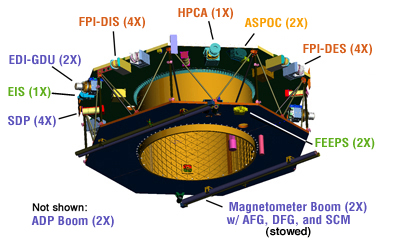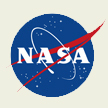Science Payload on MMS
The SMART payload on MMS is made up of three instrument groups: Hot Plasma, Energetic Particles, and FIELDS. In addition, the payload includes two Active Spacecraft Potential Control Devices (ASPOC) and a Central Instrument Data Processor (CDIP). The ASPOCs neutralize the electrical potential of the spacecraft. The CIDP provides the interface between instruments and the spacecraft subsystem. The ASPOCs are being developed at the Institut fuer Weltraumforschung of the Austrian Academy of Sciences; the CIDP is being developed at Southwest Research Institute.

Hot Plasma Instruments
- Fast Plasma Instrument (FPI)
The FPI consists of Dual Ion Sensors and Dual Electron Sensors measuring 3D ion and electron flux distributions over the energy range ~10 eV to 30 keV with an energy resolution of 20%. Electrons will be measured with a time resolution of 30 ms, ions with a time resolution 150 ms. FPI development is led by Goddard Space Flight Center. - Hot Plasma Composition Analyzer (HPCA)
The HPCA employs a novel RF technique to measure minor ions such as oxygen and helium in regions of high flux. Energy range = ~10 eV to 30 keV; energy resolution = 20%; time resoluton = 15 s. HPCA development is led by SouthWest Research Institute.
- Fly's Eye Energetic Particle Sensor (FEEPS)
Two FEEPS will measure 3D energetic ion and electron flux distributions over the energy ranges ~25 keV to 500 keV (electrons) and ~45 keV to 500 keV (ions). Time resolution = 10 s. FEEPS development is led by Aerospace Corporation. - Energetic Ion Spectrometer (EIS)
EIS uses a time-of-flight/pulse-height sensor to provide ion composition measurements (protons vs. oxygen ions) and angular distributions over the energy range ~45 keV to 500 keV and with a temporal resolution of 30 s. EIS development is led by Applied Physics Laboratory.
The FIELDS investigation is an advanced suite of six sensors measuring critical electric and magnetic fields in and around reconnection regions. Investigation is led by University of New Hampshire.
- Analog Fluxgate (AFG) and Digital Fluxgate (DFG) Magnetometers
AFG and DFG sensors are provided by UCLA and the Technical University of Braunschweig, respectively. C. T. Russell (UCLA) has overall responsibility for fluxgate development. Two kinds of magnetometers provide redundant measurements of the magnetic field and structure in the diffusion region. - Electron Drift Instrument (EDI)
The EDI determines the electric and magnetic fields by measuring the drift of ~1 keV electrons emitted from the Gun Detector Unit (GDU). Each GDU sends (receives) a coded beam to (from) the other EDI-GDU. The EDI gun is being developed at the Institut fuer Weltraumforschung of the Austrian Academy of Sciences; EDI optics are being developed at the University of Iowa.
- Double Probes
MMS requires two sets of double-probe instruments. The Spin-plane Double Probe (SDP) consists of four 48-meter wire booms with spherical sensors at the end. The Axial Double Probe (ADP) consists of two 10-meter antennas deployed axially near the spacecraft spin axis. The SDP and ADP provide full 3D electric field measurements over a range from DC to 100 kHz with an accuracy of 0.5 mV/m (SDP) and 1 mV/m (ADP).
- Search Coil Magnetometer (SCM)
The SCM will measure the 3-axis AC magnetic field up to 6 kHz and will be used with the ADP and SDP to determine the contribution of plasma waves to the turbulent dissipation occuring in the diffusion region. Development is at the Centre d'etude des Environnements Terrestre et Planetaires, France.
The four spacecraft will be built, integrated, and tested at NASA's Goddard Space Flight Center, which is also repsonsible for mission operations. Science operations, planning, and instrument command sequence development will be done at the MMS Science Operations Cener (SOC) located at the University of Colorado's Laboratory for Atmospheric and Space Physics in Boulder, Colorado.

